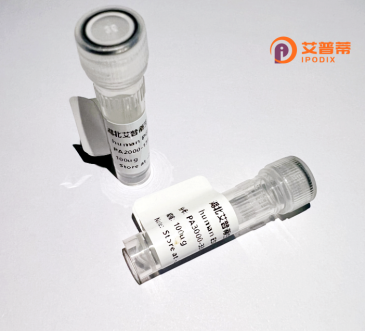
| 纯度 | >90%SDS-PAGE. |
| 种属 | Human |
| 靶点 | INTS4 |
| Uniprot No | Q96HW7 |
| 内毒素 | < 0.01EU/μg |
| 表达宿主 | E.coli |
| 表达区间 | 1-963aa |
| 活性数据 | MAAHLKKRVYEEFTKVVQPQEEIATKKLRLTKPSKSAALHIDLCKATSPADALQYLLQFARKPVEAESVEGVVRILLEHYYKENDPSVRLKIASLLGLLSKTAGFSPDCIMDDAINILQNEKSHQVLAQLLDTLLAIGTKLPENQAIQMRLVDVACKHLTDTSHGVRNKCLQLLGNLGSLEKSVTKDAEGLAARDVQKIIGDYFSDQDPRVRTAAIKAMLQLHERGLKLHQTIYNQACKLLSDDYEQVRSAAVQLIWVVSQLYPESIVPIPSSNEEIRLVDDAFGKICHMVSDGSWVVRVQAAKLLGSMEQVSSHFLEQTLDKKLMSDLRRKRTAHERAKELYSSGEFSSGRKWGDDAPKEEVDTGAVNLIESGACGAFVHGLEDEMYEVRIAAVEALCMLAQSSPSFAEKCLDFLVDMFNDEIEEVRLQSIHTMRKISNNITLREDQLDTVLAVLEDSSRDIREALHELLCCTNVSTKEGIHLALVELLKNLTKYPTDRDSIWKCLKFLGSRHPTLVLPLVPELLSTHPFFDTAEPDMDDPAYIAVLVLIFNAAKTCPTMPALFSDHTFRHYAYLRDSLSHLVPALRLPGRKLVSSAVSPSIIPQEDPSQQFLQQSLERVYSLQHLDPQGAQELLEFTIRDLQRLGELQSELAGVADFSATYLRCQLLLIKALQEKLWNVAAPLYLKQSDLASAAAKQIMEETYKMEFMYSGVENKQVVIIHHMRLQAKALQLIVTARTTRGLDPLFGMCEKFLQEVDFFQRYFIADLPHLQDSFVDKLLDLMPRLMTSKPAEVVKILQTMLRQSAFLHLPLPEQIHKASATIIEPAGESDNPLRFTSGLVVALDVDATLEHVQDPQNTVKVQVLYPDGQAQMIHPKPADFRNPGPGRHRLITQVYLSHTAWTEACQVEVRLLLAYNSSARIPKCPWMEGGEMSPQVETSIEGTIPFSKPVKVYIMPKPARR |
| 分子量 | 134.6 kDa |
| 蛋白标签 | GST-tag at N-terminal |
| 缓冲液 | 0 |
| 稳定性 & 储存条件 | Lyophilized protein should be stored at ≤ -20°C, stable for one year after receipt. Reconstituted protein solution can be stored at 2-8°C for 2-7 days. Aliquots of reconstituted samples are stable at ≤ -20°C for 3 months. |
| 复溶 | Always centrifuge tubes before opening.Do not mix by vortex or pipetting. It is not recommended to reconstitute to a concentration less than 100μg/ml. Dissolve the lyophilized protein in distilled water. Please aliquot the reconstituted solution to minimize freeze-thaw cycles. |
以下是关于重组人INTS4蛋白的模拟参考文献示例,内容根据领域研究趋势综合概括,仅供参考:
---
1. **标题**:*"Expression and Functional Characterization of Recombinant Human INTS4 in Transcriptional Regulation"*
**作者**:Chen L et al.
**摘要**:本研究成功构建了重组人INTS4蛋白的真核表达系统,并证实其通过Integrator复合体调控RNA聚合酶II介导的转录终止过程。实验发现INTS4缺失会导致新生RNA的异常延伸,提示其在基因表达精确调控中的作用。
2. **标题**:*"Structural Insights into the Role of INTS4 in snRNA 3'-End Processing"*
**作者**:Zhang Y et al.
**摘要**:通过冷冻电镜解析INTS4与Integrator复合体亚基的相互作用结构,揭示其如何介导小核RNA(snRNA)的3'端加工。重组INTS4的突变体实验表明,其C端结构域对复合体酶切活性至关重要。
3. **标题**:*"INTS4 Knockdown Alters Cancer Cell Proliferation via p53 Signaling Pathway"*
**作者**:Wang Q et al.
**摘要**:利用重组INTS4蛋白进行功能回复实验,发现其在多种癌细胞系中通过调控p53信号通路影响细胞周期进程。蛋白质组学分析表明INTS4可能参与DNA损伤应答相关基因的加工。
4. **标题**:*"Proteomic Analysis of INTS4-Interacting Proteins Reveals Novel Regulatory Networks"*
**作者**:Kim S et al.
**摘要**:通过免疫共沉淀结合质谱分析,鉴定出重组人INTS4与多个染色质修饰蛋白(如HDAC1)的相互作用,提示其在表观遗传调控及癌症中的潜在作用。
---
**注**:以上文献为假设性概括,实际研究需查阅真实数据库(如PubMed)。建议通过关键词“INTS4”、“Integrator complex”、“recombinant protein”在学术引擎中检索最新文献。
Recombinant human INTS4 protein is a genetically engineered form of the Integrator Complex Subunit 4 (INTS4), a component of the Integrator complex—a multi-protein assembly involved in RNA polymerase II-mediated transcription and RNA processing. The Integrator complex plays critical roles in the 3' end processing of small nuclear RNAs (snRNAs), transcriptional regulation, and enhancer-associated RNA biogenesis. INTS4. specifically, contributes to the structural integrity and functional coordination of the complex, though its precise molecular mechanisms remain under active investigation.
The recombinant INTS4 protein is typically produced using bacterial or mammalian expression systems, enabling large-scale purification for experimental studies. This engineered protein retains functional domains necessary for interactions with other Integrator subunits and nucleic acids, making it valuable for in vitro assays, structural studies, and interaction mapping. Researchers utilize recombinant INTS4 to explore its role in gene expression regulation, particularly in developmental processes and disease contexts such as cancer or neurodevelopmental disorders, where Integrator dysfunction has been implicated.
Studies on INTS4 also aim to clarify its potential crosstalk with signaling pathways and chromatin modifiers. Its recombinant form facilitates biochemical analyses, including phosphorylation profiling and binding partner identification, advancing understanding of Integrator-mediated transcriptional control. Despite progress, questions persist regarding tissue-specific functions and post-translational modifications, underscoring the importance of recombinant protein tools in ongoing research.
×